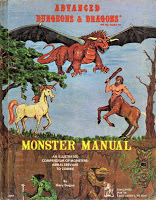 So I’m busily in the process of outlining the three core books that will form Project Shibboleth; a Players Guide, a Game Masters Guide, and a Bestiary. That has caused me to give some serious thought to how the monsters will be organized. Back in ’85, EGG opined:
So I’m busily in the process of outlining the three core books that will form Project Shibboleth; a Players Guide, a Game Masters Guide, and a Bestiary. That has caused me to give some serious thought to how the monsters will be organized. Back in ’85, EGG opined:
“I am desirous of presenting creatures by region (or plane, subterranean, and similar categorical means) so as to make the work serve as a reasonable random encounter reference as well.” (Dragon #103, November 1985)
I’m not sure about the idea of breaking monsters down into such small boxes (arctic, underground, mountain-dwellers, etc.), because I think that would fragment things just too much and make the book unusable as a reference, for all of Gygax’s good intentions regarding making it a random encounter tool. However, my recent experience with the Castle of the Mad Archmage has led me to conclude that some level of differentiation between creature types wouldn’t be out of order, especially when you consider that beasties from the Monster Manual, Fiend Folio, and Monster Manual II (as well as some new ones) will all be included together. That leads me to consider the following as a useful, and not overly granular, breakdown:
- Wilderness and Dungeon Monsters
- Underwater and Waterborne Monsters
- Prehistoric Monsters (which would naturally include all those dinosaurs)
- Extra-planar Monsters
I combine the wilderness and dungeon monsters because there’s so much overlap between them. Humanoids, giants; tons of things can be encountered both in a desolate wilderness and a deep dungeon level. But when you’re putting together an adventure, you’re probably going to know if the focus is on land or in the water. Ditto prehistoric monsters; they tend to cluster together in specialized regions, and are thus best presented together.
I break out extra-planar monsters because they, more than anything else, are unique unto themselves. I had thought about breaking out undead, but I think a comprehensive undead encounter table will fulfill that function (I’m planning on moving the random encounter tables to this book, and there will be a comprehensive index into the bargain).









I am very firmly of the opinion that alphabetical organization is optimal.
What Blair said – any other way means that you can't find the monster you want when you need it. Lists of monsters by theme are a much better idea if you want to preserve the basic idea ehre.
I'm with Blair and Nick. Alphabetical is the way to go.
So… you're all saying if you're looking for the entry for a triton, you'd be less able to find it if all underwater creatures were in their own section?
Either way works for me, but if you're going to categorize them, I'd give the Undead their own section.
FWIW, I agree with the alphabetical crew: it's faster to find monsters (but, ironically, I definitely prefer spells grouped by level vs. listed alphabetically like in 3.x). I'm sure I could get used to looking for monsters by some high-level categories, too, in time.
New players, however, might be lost, since they may not know a triton from a titanothere, however, or where to find one. I see an alphabetical organization being more important for newbies vs. experienced players.
Allan.
Alphabetical works for pure reference but, ironical, the broad catagories you suggest are tidy from a scenario designer's point of view as it pulls out all the stuff that would otherwise get in the way.
So, perhaps, main description and information in alphabetical form as at present, with a couple of tables broken out as you suggest with either a thumbnail of the monster and/or page reference to the main body of entries?
I agree that I think alphabetical would be the way to go, with one or more indexes in the back where the monsters are sorted by level, habitat, etc. with the appropriate page references.
Why choose? Publish a fine text in alphabetic order for those of us who are bibliophiles; but, have the material completely available online and sortable in multiple ways.
Total agreement here. Alphabetic makes most sense. It's way easier to make tables according to type or habitat using only the names.
You can have multiple tables sorted to different quaint methods if you use the less verbose format, i.e. only names.
I think alphabetic order have proved its use since 1980 or so…
I also think that alphabetical presentation is the best, with encounter tables in an appendix.
I suddenly am reminded of how James Maliszewski told Joe not to bother with what anyone said about this project. I'm beginning to see why…
LOL Andreas… His wise words never left my mind, reading these replies. 😉
Who is your audience? How would they like the book to be organized?
And can you divide all the critters, or do some end up as borderline cases, or in more than one category?
I would like to add my vote to Alphabetical order – with a section in the back which lists what creatures can be found in what environments for encounter planning.